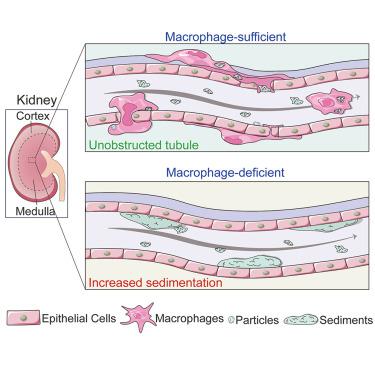Immunity ( IF 32.4 ) Pub Date : 2023-12-29 , DOI: 10.1016/j.immuni.2023.12.003 Jian He , Yangyang Cao , Qian Zhu , Xinge Wang , Guo Cheng , Qiang Wang , Rukun He , Haoran Lu , Yuancheng Weng , Genxiang Mao , Yizhong Bao , Jing Wang , Xiaoli Liu , Fei Han , Peng Shi , Xiao Z. Shen

|
When the filtrate of the glomerulus flows through the renal tubular system, various microscopic sediment particles, including mineral crystals, are generated. Dislodging these particles is critical to ensuring the free flow of filtrate, whereas failure to remove them will result in kidney stone formation and obstruction. However, the underlying mechanism for the clearance is unclear. Here, using high-resolution microscopy, we found that the juxtatubular macrophages in the renal medulla constitutively formed transepithelial protrusions and “sampled” urine contents. They efficiently sequestered and phagocytosed intraluminal sediment particles and occasionally transmigrated to the tubule lumen to escort the excretion of urine particles. Mice with decreased renal macrophage numbers were prone to developing various intratubular sediments, including kidney stones. Mechanistically, the transepithelial behaviors of medulla macrophages required integrin β1-mediated ligation to the tubular epithelium. These findings indicate that medulla macrophages sample urine content and remove intratubular particles to keep the tubular system unobstructed.
中文翻译:

肾巨噬细胞监测并清除尿液中的颗粒,以防止肾小管阻塞
当肾小球的滤液流经肾小管系统时,会产生各种微小的沉积物颗粒,包括矿物晶体。去除这些颗粒对于确保滤液自由流动至关重要,而未能去除它们将导致肾结石形成和阻塞。然而,清除的根本机制尚不清楚。在这里,使用高分辨率显微镜,我们发现肾髓质中的近管巨噬细胞组成性地形成跨上皮突起并“取样”尿液内容物。它们有效地隔离和吞噬管腔内的沉积物颗粒,并且偶尔迁移到肾小管腔以护送尿液颗粒的排泄。肾巨噬细胞数量减少的小鼠容易出现各种肾小管内沉积物,包括肾结石。从机制上讲,髓质巨噬细胞的跨上皮行为需要整合素β1介导的与管状上皮的连接。这些发现表明髓质巨噬细胞对尿液内容物进行采样并去除肾小管内颗粒以保持肾小管系统畅通无阻。



























 京公网安备 11010802027423号
京公网安备 11010802027423号